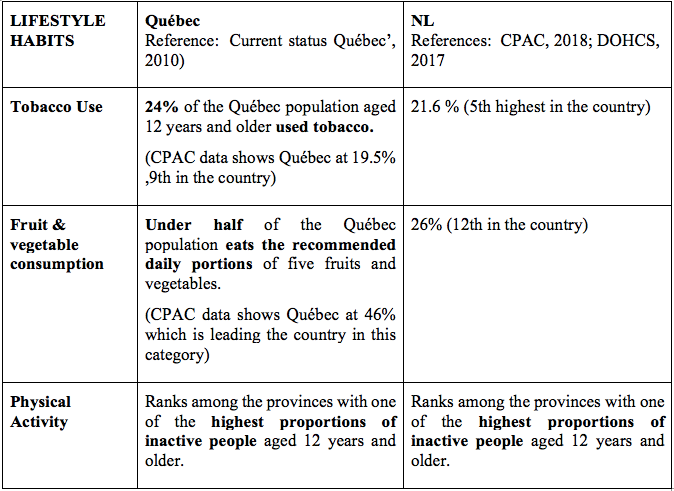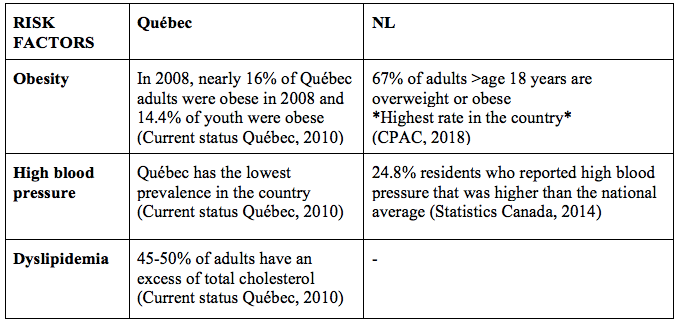Chronic Disease in Canada - Québec and Newfoundland & Labrador
- Sabrina P.
- Mar 10, 2018
- 5 min read
Blog post by: Sabrina Primiano & Lori Manuel
Chronic disease is defined by the Word Health Organization (WHO) as noncommunicable diseases (NCDs) that are not passed from person to person (WHO, 2018). They are of long duration and generally slow progression. The four main types of noncommunicable diseases are cardiovascular diseases (heart attacks and stroke), cancers, chronic respiratory diseases (chronic obstructed pulmonary disease and asthma) and diabetes.
This blog will compare chronic health conditions between the provinces of Newfoundland and Labrador (NL) and Quebec (QC).

NL is the most easterly province in Canada and has a population of 530,000 while Quebec borders Labrador and Ontario and has a population of 8.2 million people.
In Québec, approximately 3.2 million people have at least one chronic health condition, which represents 48% of the population aged 15 and over (Carrier, 2014).
Arthritis affects 16% of the population
Hypertension affects 17% of the population
Heart disease and diabetes affects 7% of the population
In NL, 63 % of NL residents over the age of 12 have at least one chronic disease and the highest rates of diabetes and hypertension across all provinces (DOHCS, Government of NL, 2017).
Arthritis affects 22.1% of the population
Chronic pain affects 21.2% of the population
Diabetes affects 9.5% of the population
Heart disease affects 6.3% of the population
Primary Determinants of Health
As we have learned in previous weeks, determinants of health are factors that influence individual and population health. The modification of certain health determinants and the accumulation of risk factors partly explain the current rise in chronic disease across Canada (‘Current status Québec’, 2010).
The following factors increase the risk of developing asthma and/or heart disease.
1. Biology and genetics: Most chronic diseases appear later on in life which explains the rise in prevalence, giving the growing phenomenon of population aging (‘Current status Québec’, 2010).
2. Lifestyle habits:

3. Risk factors:

Act Respecting Local Health and Social Services Network Development Agencies governs QC’s health and social services system. The objectives are to “prevent, cure and support”. The vision is based on a population approach, on collective responsibility for health, and on networking local care and services. NL has developed a chronic disease action plan chronic disease action plan titled “The Way Forward” (DOHCS, 2017). This plan includes prevention initiatives, self-management initiatives and treatment and care initiatives.
Chronic Disease Surveillance
Surveillance plays of chronic disease can play a significant role in improving prevention and control.
QC: The Institut National de Santé Publique du Québec has developed a chronic disease surveillance system called the Québec Integrated Chronic Disease Surveillance System (QICDSS) (Blais et al., 2014). The QICDSS was created by linking five health administrative databases and is updated annually (Blais et al., 2014). The QICDSS allows the surveillance of diabetes, cardiovascular diseases, respiratory diseases, osteoporosis, osteoarticular disease, mental disorders, Alzheimer’s disease and related disorders through a specific selection criterion, which includes: (1) extraction and linkage of health administrative data according to specific selection criteria; (2) analysis and production of surveillance measures; (3) data interpretation, submission and dissemination of information (Blais et al., 2014).
NL: There is a focus on improved integration of current provincial population based cancer screening programs (breast, colon and cervical). NL recently received registry status for its 3 screening programs and cancer care registry. The cancer registry will be used to invite people to participate in screening. An example of improving prevention is the BETTER program which has been initiated to enhance skills of targeted health providers to provide one on one lifestyle coaching.
Chronic Disease Management
QC: The care and services for people with chronic diseases are provided through a local healthcare and social service network (RLS) coordinated by a health and social service centre (CSSS). Responsible for implementing the population approach, the CSSS is mandated to improve the health and welfare of its service population either through health-promotion initiatives or through the management of more vulnerable individuals.
NL: There is a focus on development and implementation of chronic disease & self management workshops and self management health coaching. Another focus on treatment in care ensures care is as close to home as possible including technologies such as telehealth and remote patient monitoring. New case management approaches are being developed for all chronic diseases and there is an emphasis on developing and implementing cancer survivorship programs. Other initiatives such as the “Strongest Families” initiative in mental health, tobacco cessation, and standardization of wound care are under development in the next two years.
Provision of Health Care Services
The Canada Health Act, which passed into law in 1984, is the overarching legislation covering Canada’s national medicare program (The Council of Canadians, n.d.). Quebec and NL are 2 of the 13 provinces and territories which are responsible for providing healthcare in their respective provinces. The Canada Health Act sets the national standards that provinces and territories must meet in order to receive funding from the Canada Health and Social Transfer (The Council of Canadians, n.d.). One important aspect of healthcare is targeted at improving the health of Canadians living with chronic disease.
QC: Regionally, health and social service agencies, which oversee the CSSSs within their respective regions, play a planning, coordination and support role in relation to the RLSs. Jointly with other regional stakeholders, they see to the organization of services in their jurisdictions to ensure and support the management of different client groups. Provincially, the Ministère de la Santé et des Services sociaux (MSSS) is mandated to oversee the entire health and social services system, from health promotion to end-of-life care. It sets directions, policies, standards and measures, besides organizing different programs, some of which specifically address chronic diseases.
NL: Regionally, there are four integrated health authorities which oversee health care in their respective Eastern, Central, Western and Labrador-Grenfell Health regions. The health authorities work with stakeholders within their respective regions to improve health of those with chronic diseases as well as a provincial strategy outlined in “The Way Forward” (DOHCS, 2017). There is a move towards centralizing health services such as the shared services of information technology and human resources. There appears to be a move in the direction of one provincial health authority as has been initiated in other provinces.
Summary comparisons
Quebec’s population is 15 times larger than NL
Health services are delivered similarly in regional health authorities48% of Quebec’s population has a chronic disease, while in NL 63% have a chronic disease
Quebec has the highest rates of fruit and vegetable consumption while NL has one of the lowest rates
Both province have high rates of obesity and physical inactivity
Both provinces have clearly defined chronic disease management strategies
References:
Bernell , S. & Howard, S. (2016). Use your words carefully: what is a chronic disease? Front
Blais, C., Jean, S., Sirois, C., Rochette, L., Plante, C., Larocque, I., . . . Emond, V. (2014). Québec
Integrated Chronic Disease Surveillance System (QICDSS), an innovative approach.
Chronic Disease and Injuries in Canada, 34(4), 226-235.
Canadian Partnership Against Cancer (CPAC) (2018). Cancer system performance. Retrieved
March 6 from http://www.systemperformance.ca/provinces/
Carrier, S. (2014, January 16). Nearly half of Québecers have a chronic health condition.
Retrieved March 07, 2018, from http://www.stat.gouv.qc.ca/salle-
presse/communique/communique-presse-2014/janvier/jan1416_an.html
Current status of chronic diseases in Québec and response of the health and social services
system. (2010). Health and Welfare Commissioner, 1-24. Retrieved March 6, 2018, f
from http://www.csbe.gouv.qc.ca/fileadmin/www/2010
/MaladiesChroniques/CSBE_T2_CurrentStatus2010.pdf
Department of Health and Community Service(DOHCS), Government of Newfoundland and
The Council of Canadians. (n.d.). Factsheet: Understanding the Canada health act. Retrieved







Comments